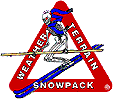Climbers Avalanche Course - Comparison with Full Level 1
This course is a shorter modified version of the full Level 1 course![]() with an emphasis on factors important in spring and in mountaineering. This is not necessarily an exhaustive list but the major differences are:
with an emphasis on factors important in spring and in mountaineering. This is not necessarily an exhaustive list but the major differences are:
Module 1 (Intro and Background) - Material on the Danger Scale is reduced. By the time spring climbing season is underway there are few advisories available at all, and those that are available often do not use the 5 level danger scale. There is also no emphasis on different snowpack climates (maritime vs. continental) as there is in a full Level 1 course. This is because (late) spring conditions during prime climbing season do not differ much between these climates, unlike winter conditions. Both topics are mentioned briefly but without the depth of a Level 1 course.
Modules 2 and 3 (Safe Travel, Equipment, Rescue) - These are identical; students in the Climbing course can take the same modules as students in the Level 1 course. Climbers do not always carry rescue equipment and in at least some situations a reasonable case for this can be made. They can also face different challenges such as small parties (often of 2 climbers roped together) and difficult access to the run-out zone. However we include this material so that they are fully familiar with the equipment should they decide to carry it and also so they have the background to mount an effective rescue if it is possible. The relevant challenges and trade-offs are mentioned in the Safe Travel and Rescue stand-alone course![]() (which constitutes Modules 2 and 3).
(which constitutes Modules 2 and 3).
Module 4 (Weather) - The weather module is much shorter than in the Level 1 course. Some basic background science is still included but the applied factors are primarily limited to radiation balance (melt-freeze weather) and new snow. Climate differences are not covered for reasons given above (see Module 1). Local and topographic effects that play a large role in winter but are not very important in spring are omitted. The topics covered are presented from a point of view of spring conditions.
Module 5 (Snowpack) - Snowpack differences between climates are not covered for reasons given above (see Modules 1 and 4). Persistent weak layers in general and surface hoar in particular are not covered since these play little to no role in a spring snowpack. Most of the same basic background theory (i.e. viscoelastic behavior, glide and creep) are retained and included here. A bit of material on melt-freeze metamorphism from the Snowpack 2 module in the full Level 1 is included here since that module itself is not part of this course. General "bulls eye" observations are still emphasized but the things to look for are the methods of observation are different.
Module 6 (Terrain) - While this may seem heretical to some at first glance there is no module at all on terrain. The reality is that mountaineering accidents don't happen during routefinding through avalanche terrain, they happen on steep routes. Once a route is chosen and attempted climbers tend to be committed to being on steep slopes for quite some time. Therefore the only effective approach to terrain is to choose a safe route for given conditions (or to go when conditions are best for a given route) to begin with during the planning phase. Terrain is covered to this extent primarily in Module 10 on planning and route selection with a few additional comments in other parts of the course.
Module 7 (Human Factors) - This module is largely the same, with some relatively minor alterations to keep it focused on climbing issues.
Module 8 (Snowpack 2) - There is no Snowpack 2 module in the climbing course. The science of snow metamorphism is not of any great importance aside from melt-freeze, and that is incorporated into Module 5 on snowpack. Snowpit profiles are also not of much importance to spring climbers.
Module 9 (Decision Support Frameworks) - This has been omitted due to a combination of its limited application and an effort to keep the climbing course much shorter. In the full course this is a lengthy module. Most of the methods covered are primarily for decision making in the field during the course of a ski tour and are of somewhat limited use to climbers whose primary field decision is whether or not to commit to a route. Most methods also rely on data, forecasts and observations that are related to winter snowpacks. Once on the route the options tend to be limited. So once again we see that the key is to plan properly.
Module 10 (Planning) - This is similar but with an emphasis is on climbing and the related issues. This is still applicable to many spring ski tours and ski mountaineering as well, which is true of most of the course material.
Students with a current Level 1 certification from us may take this course at no cost as it is considered supplemental material. On the other hand, students who complete this may apply the course value towards a full Level 1 course.

 Avalanche Institute Home
Avalanche Institute Home